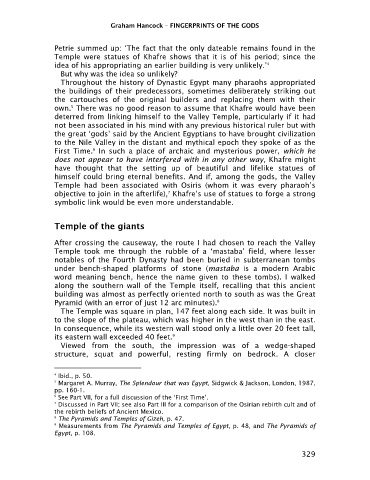Page 331 - Fingerprints of the Gods by Graham Hancock
P. 331
Graham Hancock – FINGERPRINTS OF THE GODS
Petrie summed up: ‘The fact that the only dateable remains found in the
Temple were statues of Khafre shows that it is of his period; since the
idea of his appropriating an earlier building is very unlikely.’
4
But why was the idea so unlikely?
Throughout the history of Dynastic Egypt many pharaohs appropriated
the buildings of their predecessors, sometimes deliberately striking out
the cartouches of the original builders and replacing them with their
own. There was no good reason to assume that Khafre would have been
5
deterred from linking himself to the Valley Temple, particularly if it had
not been associated in his mind with any previous historical ruler but with
the great ‘gods’ said by the Ancient Egyptians to have brought civilization
to the Nile Valley in the distant and mythical epoch they spoke of as the
First Time. In such a place of archaic and mysterious power, which he
6
does not appear to have interfered with in any other way, Khafre might
have thought that the setting up of beautiful and lifelike statues of
himself could bring eternal benefits. And if, among the gods, the Valley
Temple had been associated with Osiris (whom it was every pharaoh’s
objective to join in the afterlife), Khafre’s use of statues to forge a strong
7
symbolic link would be even more understandable.
Temple of the giants
After crossing the causeway, the route I had chosen to reach the Valley
Temple took me through the rubble of a ‘mastaba’ field, where lesser
notables of the Fourth Dynasty had been buried in subterranean tombs
under bench-shaped platforms of stone (mastaba is a modern Arabic
word meaning bench, hence the name given to these tombs). I walked
along the southern wall of the Temple itself, recalling that this ancient
building was almost as perfectly oriented north to south as was the Great
Pyramid (with an error of just 12 arc minutes).
8
The Temple was square in plan, 147 feet along each side. It was built in
to the slope of the plateau, which was higher in the west than in the east.
In consequence, while its western wall stood only a little over 20 feet tall,
its eastern wall exceeded 40 feet.
9
Viewed from the south, the impression was of a wedge-shaped
structure, squat and powerful, resting firmly on bedrock. A closer
4 Ibid., p. 50.
5 Margaret A. Murray, The Splendour that was Egypt, Sidgwick & Jackson, London, 1987,
pp. 160-1.
6 See Part VII, for a full discussion of the ‘First Time’.
7 Discussed in Part VII; see also Part III for a comparison of the Osirian rebirth cult and of
the rebirth beliefs of Ancient Mexico.
The Pyramids and Temples of Gizeh, p. 47.
8
9 Measurements from The Pyramids and Temples of Egypt, p. 48, and The Pyramids of
Egypt, p. 108.
329

